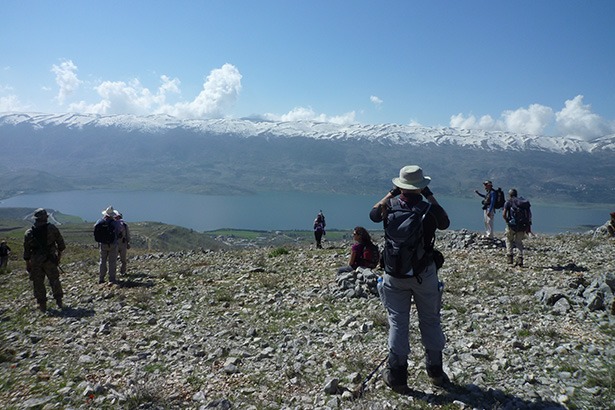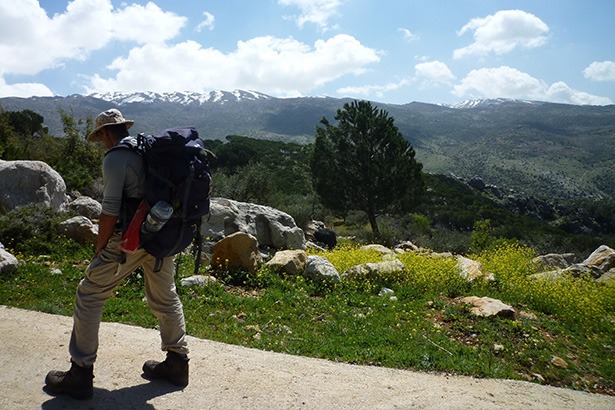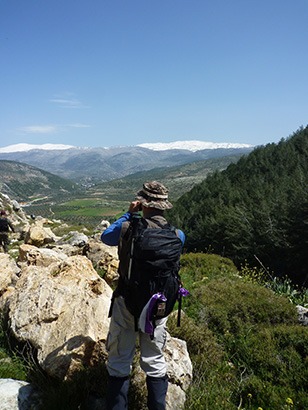Our intrepid reporter, Sabina Llewellyn Davies, discovered stunning sights, rural culture, ancient history and fabulous food when she joined the Lebanon Mountain Trail hikers for a few days.
It’s a warm spring morning in April. Under a canopy of bright blue, we tread along a worn track, past groves of ancient olive trees, retracing the tracks of bygone travelers, traders and shepherds. Then, a steep descent, down a rocky hillside, leads us towards a makeshift Bedouin camp. We stop in our tracks to chat with the local women and children who are harvesting wild herbs. A cow is resting in the grass with its newborn calf. It just gave birth that morning, says one of the children.
We had woken up early that day at around 6 a.m., all set to trek the Mayjaoun to Hasbaya section of the Lebanon Mountain Trail (LMT)(+961 5 955 302), around 16 km. “I really want to discover my own country,” says Lebanese born Mustapha Kandil, CEO of Impress Advertising, who has lived in Dubai since the eighties. Mustapha is one of the five core walkers determined to complete the LMT Thru Walk, around 440 km, joined by other hikers along the way.

We are a mixed bunch of hikers, all ages, backgrounds and nationalities. Christian Akrass, our resourceful trek leader and field coordinator of the Lebanon Mountain Trail Association (LMTA), moves us along after a thorough briefing of the trail, plus the LMTA’s objectives. “We aim to expand economic opportunities in rural areas through responsible tourism.” Christian informed us. “We still have 15 more kilometers to Hasbaya,” he said. “Yalla, let’s go.”
The theme of this year’s Thru Walk is water conservation. “We pass around 65 springs along the trail and hope to raise awareness for this issue so that the locals will protect the springs and their surroundings,” says Christian. Protection of the trails and the environment is high on the agenda for Paul Khawaja, head of mission at the British Embassy, who is also vice-president of the LMTA. He points to a road, “This was not here two years ago. We [the LMTA] are doing our best to protect the trails and we hope that this year’s Thru Walk will raise awareness.”
Using the services of a local guide to trek the LMT is definitely recommended. We’re able to gain a deeper insight into Lebanon’s rural regions through the eyes of a local, as well as provide the rural folk with some welcome income. Today, we are joined by Wael Shmeis, a 26-year-old from the village of Hasbaya. Beaming, he leads us along the trail with a bounce in his step, pointing out the names of wildflowers and trees. Suddenly, he stops in his track and peeks down. “Look, a tortoise.”

The 26 sections of the LMT range from easy to difficult and are 10 to 24 kilometers in length. While much of the trail is spent trekking flat terrain, there are also challenging rocky paths ascending to high points. The reward at the end of each day’s hike is an overnight stay at a low-key rural lodging, often the home of a local villager. Staying with a family is also a direct channel for putting money into the villager’s pockets. Around forty families will benefit from this year’s Thru Walk. And, supper is always a delicious surprise. Expect regional specialties such as vine leaves and fattoush salad, or maybe even a rarity like the akkoub vegetable, a specialty of the south, served in a garlicky yogurt sauce.

That night, Wael’s family welcomed us into their riverside home in Hasbaya. After a well-earned shower, we devoured our supper and then walked around the village in search of ice cream. Agreeing that there was not an inch left in our stomachs, we headed back to Wael’s home, crawled into our sleeping bags and fell asleep to a chorus of frogs croaking from the nearby riverbank.
After an early rise the next day, a delicious breakfast of eggs, yogurt, cheese and an exceptional fig jam with walnuts made by Wael’s mother, awaits us. “Only 24 kilometers to reach the village of Rashaya,” says Christian, grinning wryly. That day the sun was strong and temperatures rose to the thirties. The ascents were steep and as we climbed the rugged footpaths with fellow hikers, our chatter was soon replaced by silence, as the trail climbed hundreds of meters. We stop and turn to take in the view of Jabal el Cheikh behind us and gasp, not out of exhaustion but rather in awe of the stunning sight of the majestic snowcapped peak.

Walking beside me is Alan Philps, a British journalist and editor, who came to Lebanon to join the Thru Walk for ten days with his author friend Desmond Astley-Cooper. “Tired?” I ask. “Exhausted,” he replies but smiles when we finally reach the top of the hill, greeted by the sight of the red roofs of Rashaya, lustrous during the sunset. The climb was well worth it we decide, as we head to the home of the local guide Mehdi el Fayik. “The whole experience of hiking on the LMT is just incredible. Not just the stunning scenery, but also staying overnight with a local family. It’s a real immersion into Lebanon’s rural culture,” says Desmond. “I wonder what’s for supper tonight?”
To find out more about the trail go to lebanontrail.org

The Lebanon Mountain Trail (LMT) is a 440 km hiking trail, funded by USAID, extending from the village of Qobaiyat in the northern Akkar region to Marjayoun in the deep South. It passes through seventy-five towns and villages, three nature reserves, ancient castles, abandoned mills and Roman ruins.
The Lebanon Mountain Trail Association (LMTA) organized its 4th Thru-Walk, from Marjayoun to Qobaiyat, in April 2012 to support rural economies in trailside communities, and to promote responsible eco-tourism in Lebanon. Around 100 hikers from over a dozen countries joined the walk.
Article edited on November 12, 2021
Loading

